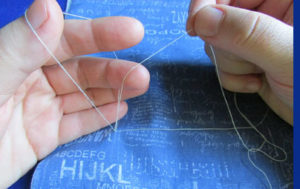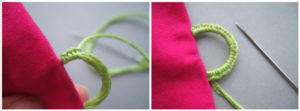A thread loop is used for hanging items, fastening buttons, and decorating children's clothing and toys. Read on to learn how to make such a loop yourself.
How to make a loop on a towel or curtains
Important! Thread loops are used on finished products in places where the load on them will be small, because in this case they will break. If the loop is not intended for decoration, then they try to place it in inconspicuous places, choosing threads to match the color of the fabric.
 To get started, you need to decide what the loop will be used in pairs with.. If for a hook, then a flat one is better suited. And if for a button, it should have the shape of an arc, rising above the edge of the material. Between the loop and the surface of the product there is space left sufficient for the button to pass freely.
To get started, you need to decide what the loop will be used in pairs with.. If for a hook, then a flat one is better suited. And if for a button, it should have the shape of an arc, rising above the edge of the material. Between the loop and the surface of the product there is space left sufficient for the button to pass freely.
Before sewing, it is advisable to make marks where the edges of the loop will be. To work, you need a hand sewing needle and thread (cotton floss is recommended).
For curtains and towels, it is better to crochet loops using smooth yarn, matched to the color of the products. It is advisable to make the towel loop long, so that you can easily put it on and take it off the hook.
Quick loop from one thread
You can quickly and easily make a loop like this:
 pierce the product and remove the needle where the loop is needed, perform several securing stitches;
pierce the product and remove the needle where the loop is needed, perform several securing stitches;- make the next stitch not completely, forming a loop from the thread;
- Throw the resulting arc onto the index and thumb, and grab the working thread with the middle finger;
- remove the thread from the thumb and index finger, and tighten the loop that goes to the middle finger with a knot;
- make the required number of knots, obtaining a column of them of the planned length, thread the working thread into the loop and tie;
- On the back side of the product, make a couple of stitches to secure it, you can tie a knot, cut the thread.
Twisted loop
This loop is an excellent hanger for outerwear. It is quite durable, neat looking, and comfortable to wear. To make it you need a strip of lining fabric, threads, and a sewing machine.. The procedure is as follows:
 fold a strip measuring 3 by 18 cm in half lengthwise and machine stitch it with the right side facing inward;
fold a strip measuring 3 by 18 cm in half lengthwise and machine stitch it with the right side facing inward;- insert the ends of the thread remaining from the seam into a needle, and use it to turn out the resulting strip;
- to turn the needle and thread forward, push the blunt end inside the strip;
- twist the resulting steering wheel around its axis as tightly as possible;
- fold in half and twist again, aligning the ends of the cord;
- Sew a harness with a loop on one side and open ends on the other to the collar, having first secured the ends of the cords with several stitches.
Crochet loop
 This loop is performed quite quickly and consists of air loops. It must be taken into account that knitted fabric can stretch when used, so you should not make them longer than required. 10 cm is enough, with a couple of centimeters added for 2 seams.
This loop is performed quite quickly and consists of air loops. It must be taken into account that knitted fabric can stretch when used, so you should not make them longer than required. 10 cm is enough, with a couple of centimeters added for 2 seams.
Loop covered with loop stitches
These items take longer to complete than others. The advantage is their neat appearance and the ability to be used for decorative purposes. For production you need:
 thread a double thread into the needle;
thread a double thread into the needle;- perform a stitch at the beginning of the loop;
- in the place where the loop ends, make a second stitch;
- repeat the same arc length 3 to 5 times;
- twist the arcs with loop stitches;
- to do this, the needle is threaded through a loop that comes out of the fabric and then tightened;
- Fasten the ends of the threads inconspicuously inside the product.
Reference. A buttonhole covered with stitches is recommended for thin fabrics, small buttons, air fasteners. It will look beautiful on children's things, when decorating doll clothes and toys.
How to process a buttonhole on a jacket by hand?
 Welt loops are often found on jackets. Many sewing machines are equipped with a sewing function. But sometimes you need to do it with your hands, if the thickness and density of the fabric does not allow this to be done by machine.
Welt loops are often found on jackets. Many sewing machines are equipped with a sewing function. But sometimes you need to do it with your hands, if the thickness and density of the fabric does not allow this to be done by machine.
If you decide to perform the process manually, you need to do the following:
- mark and cut the loop;
- sew the sections with loop stitches, trying to make them the same;
- At the beginning and end of the loop, the stitches should be longer.
Important! When processing a loop, precision is needed; use a water-soluble marker for marking. The density and length of the stitches should be uniform. Do not tighten the thread.Practice on another piece of paper first. If you put a thread along the cut, the loops will gain relief.
Whatever type of hinge you choose, if they are made correctly, they will last a long time, be comfortable and delight others with their appearance. Perhaps your imagination will suggest new options for using thread loops and they will find a place in your creativity.


 pierce the product and remove the needle where the loop is needed, perform several securing stitches;
pierce the product and remove the needle where the loop is needed, perform several securing stitches; fold a strip measuring 3 by 18 cm in half lengthwise and machine stitch it with the right side facing inward;
fold a strip measuring 3 by 18 cm in half lengthwise and machine stitch it with the right side facing inward; thread a double thread into the needle;
thread a double thread into the needle; 0
0





